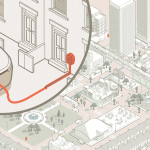A gray-haired Dartmouth professor was tackled, zip-tied, and detained on May 1 along with about 90 other protesters. “I’ve been teaching here for 34 years,” Annelise Orleck told The New York Times after video of the arrest went viral. “There have been many protests, but I’ve never, ever seen riot police called to the green.”
Much of the debate about the campus protests sparked by the Israel-Hamas war has centered—quite reasonably—on questions around free speech, civil disobedience, and violence. When do chants become threats? When does blocking access to a building become the use of force? Less attention has been paid to the role of policing. But even as Americans have become numb to the militarization of police in other contexts, there’s something shocking about the sight of cops in riot gear on college campuses.
About 2,700 protesters have been arrested or detained at dozens of schools this spring. At UCLA, nearly 200 arrests recently occurred, with police stepping in many hours after counterprotesters attacked the encampment. At the University of Virginia, students (and one Reason reporter) were hit with pepper spray and then hauled off the lawn along with their tents; 25 students were arrested or detained.
While clearing an encampment at Columbia, the New York Police Department (NYPD) used a specialized vehicle with a ramp, nicknamed “the bear,” to access the second story of a building occupied by a few dozen students. Police stormed the building and the encampment outside it wearing helmets and wielding ballistic shields. They used flash-bang grenades. One New York Police officer discharged a weapon in the university’s Hamilton Hall. (An NYPD spokesman later told a local publication, The City, that the officer had been using a firearm “equipped with a flashlight” to see around an area barricaded by students when he fired the gun “accidentally.”)
Witnesses initially posted on X that they thought the vehicle was an MRAP, or mine-resistant ambush protected vehicle, which became popular with police departments in the wake of the 1033 Program, a 1990s George H.W. Bush–era* initiative to hand off Department of Defense surplus to local law enforcement. That program has been somewhat curtailed, but the taste for such vehicles has not. “The bear” turned out to be a BearCat, a tactical vehicle now popular with police and available from a private supplier. The NYPD has several; a batch acquired in 2005 cost $225,000 apiece.
In the decade since former Reason reporter Radley Balko wrote Rise of the Warrior Cop, most major cities—and plenty of college towns—have seen a normalization of the paramilitary mindset for policing, as well as the use of SWAT teams in routine police action.
But the use of these tactics on college campuses in the context of political protest should be an occasion to examine the tools and powers given to police—and the difficulty of the task assigned to them.
In summer 2020, aggressive policing was both under debate and on display, as protests over the death of George Floyd at the hands of Minneapolis police flooded the streets. The urban crime spike that followed those protests was blamed, in part, on the possibility that cops might have become overly cautious or disaffected in light of national scrutiny. But in most cities, the crime wave has receded, calling that explanation into question. (Washington is an exception, for reasons that resist simple explanation, as one D.C. neighborhood commissioner, Joe Bishop-Henchman, explains.) Around the same time, homeless tent camps began to multiply in cities, raising difficult questions about the policing of camping in public and semi-public spaces—questions that have been reraised by the tent camps of college kids. (Reason‘s C.J. Ciaramella looks to Miami for answers to the homelessness problem.)
Universities tend to lack the wherewithal to clear encampments themselves, even if rules about the time, place, and manner of protests are clear, content-neutral, and unambiguously constitutional. In the case of the Dartmouth arrests, the police swooped in mere hours after the first sign of an encampment, at the request of the university president. But as national attention to that decision and the disasters at Columbia, UCLA, and elsewhere make clear, many universities were right to be cautious when calling in off-campus law enforcement.
The mindset and training of law enforcement is unlikely to be suited to the delicacy of the situation. Nor are local police likely to be up to date on the subtleties of First Amendment–protected conduct. For now, college presidents (and the U.S. president) seem to have internalized the lessons of Kent State and have resisted the temptation to involve the actual military. The arrests at Dartmouth took place on the 54th anniversary of the Ohio National Guard’s shooting of four students on that campus over anti-war protests, but enforcement has been strictly civilian so far.
But this leaves colleges and cops in a difficult position, and not one of their own making. Though the protesters often have demands for campus administrators, typically about divestment and diversity, those asks tend to be minor and mostly beside the point. They are angry about U.S. involvement in an overseas conflict, something the victims and targets of their protests have very little power to change. But with obsessive national political attention on college campuses already, the temptation to make a fuss on campus is too strong to ignore.
Likewise, by equipping themselves to be as large and terrifying as possible, police have paradoxically limited their ability to deal with the kind of human-scale problems that actually arise in 2024, whether it’s crime, homelessness, or protest.
Elsewhere in this issue, Editor at Large Matt Welch analyzes the distortions in U.S. foreign policy caused by the massive buildup of American armed forces, as epitomized by former Secretary of State Madeleine Albright’s famous 1993 query: “What’s the point of having this superb military you’re always talking about if we can’t use it?”
The same mindset has taken hold domestically. Both abroad and at home, the American way is now to send expensively overequipped cops barging into situations that desperately need de-escalation instead.
*CORRECTION: The original version of this article misstated which presidential administration was responsible for the 1033 program.
The post SWAT Goes to College appeared first on Reason.com.







